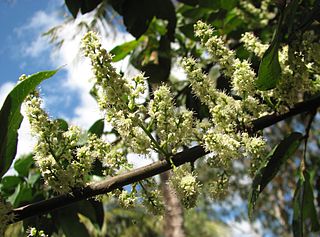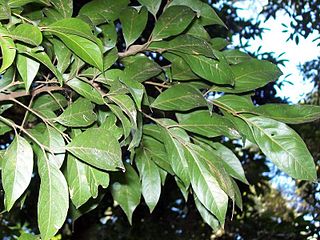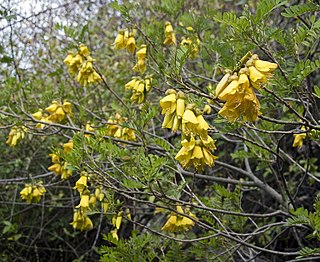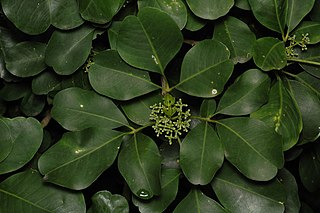
Guioa is a genus of about 78 rainforest tree species known to science, which constitute part of the plant family Sapindaceae. They have a wide distribution, ranging from throughout Malesia, in Burma, Cambodia, Vietnam, Thailand, Malay Peninsula, Borneo, Sumatra, Philippines, Java, Flores, Timor, Sulawesi, Moluccas, New Guinea, further southwards through the east coast of Queensland and New South Wales, Australia and further eastwards to the Pacific Islands, including Tonga, New Caledonia, Fiji and Samoa.

Guioa semiglauca, known as the guioa or wild quince, is a rainforest tree of eastern Australia. It grows from Kioloa near Batemans Bay in southern New South Wales to Eungella National Park in tropical Queensland. It grows in many different types of rainforest, particularly common in regenerating areas and on sand in littoral rainforest.

Diploglottis australis, known as the native tamarind, is a well known rainforest tree of eastern Australia. It is easily identified by the large sausage shaped leaflets.

Drypetes deplanchei is a tree of eastern and northern Australia. It also occurs in New Caledonia and Lord Howe Island. The genus is derived from the Greek, dryppa meaning "olive fruit". The species named after Dr. Emile Deplanche, who collected this plant at New Caledonia. Common names include yellow tulip, grey boxwood, white myrtle, grey bark and yellow tulipwood.

Sarcopteryx stipata, known as the steelwood, is a rainforest tree of eastern Australia occurring from the Bulga Plateau and Comboyne Plateau north west of Taree, New South Wales as far north as Fraser Island off the coast of south eastern Queensland. It grows in sub tropical rainforest but sometimes occurs in warm temperate rainforests on poorer soils. It is a member of the soap berry family. The generic name Sarcopteryx translates to "fleshy wing", as the fruit can be wing shaped. Stipata means "surrounded". The common name steelwood refers to the very tough, hard and heavy timber.

Elattostachys xylocarpa, known as the white tamarind or short-leaf beetroot is a common rainforest tree of eastern Australia. Found in the drier rainforests, which are based on volcanic soils. From as far south as the Orara River in northern New South Wales to Bowen in tropical Queensland. The name Elattostachys refers to "little spikes", a flower feature of other plants in this genus. xylocarpa refers to the hard woody fruit.

Negria is a plant genus in the family Gesneriaceae. Its only species is Negria rhabdothamnoides, commonly known as the pumpkin tree, which is endemic to Australia's subtropical Lord Howe Island in the Tasman Sea. It is related to Lenbrassia and Depanthus.

Cupaniopsis wadsworthii, sometimes commonly named duckfoot and scrub tuckeroo, is an Australian species of shrubs of the flowering plant family Sapindaceae. The grow naturally in rainforests and seasonally dry rainforests, noted as usually "on hill slopes in rocky soil", from Magnetic Island southwards to about Bulburin National Park, central eastern Queensland.

Sophora howinsula, commonly known as lignum vitae or Lord Howe kowhai, is a flowering plant in the legume family. The specific epithet refers to the island to which the species is endemic.
Coprosma huttoniana is a flowering plant in the family Rubiaceae. The specific epithet honours Ian Hutton, the Lord Howe Island based naturalist who discovered the plant and recognised it as a new species.
Coprosma inopinata is a flowering plant in the family Rubiaceae. The specific epithet comes from the Latin inopinus (“unexpected”), because it was discovered unexpectedly in 1989, proving to be yet another species of Coprosma that was endemic to Lord Howe Island.

Coprosma putida, commonly known as stinkwood, is a flowering plant in the family Rubiaceae. The specific epithet comes from the Latin puteo, alluding to the stench produced when the species is cut or bruised, including the leaves and fruit.
Psychotria carronis, commonly known as the Black Grape, is a flowering plant in the coffee family. The specific epithet honours William Carron (1823–1876) who collected plants on Lord Howe Island for the Royal Botanic Gardens, Sydney.
Melicope contermina is a species of shrub or small tree in the family Rutaceae and is endemic to Lord Howe Island. It has trifoliate leaves and white flowers borne in leaf axils in panicles of nine to fifteen flowers.

Melicope polybotrya is a species of shrub or small tree in the family Rutaceae and is endemic to Lord Howe Island. It has trifoliate leaves and green flowers borne in short panicles in leaf axils.
Exocarpos homalocladus, commonly known as the grass tree, is a flowering plant in the sandalwood family. The specific epithet comes from the Greek homalos (“flat”) and clados, with reference to the structure of the plant.
Symplocos candelabrum is a flowering plant in the sapphireberry family. The specific epithet may refer to the candelabrum-like display of stamens in the flower.

Drypetes deplanchei subsp. affinis, commonly known as greybark or grey bark, is a flowering plant in the Putranjivaceae family. The subspecific epithet affinis alludes to its similarity to Drypetes sepiaria of India and Sri Lanka.
Piper excelsum subsp. psittacorum, commonly known as pepper tree or kava, is a flowering plant in the family Piperaceae. The subspecific epithet means “of the parrots”, inferring a liking by parrots for the fruits.

Zanthoxylum pinnatum, commonly known as yellow wood, is a species of flowering plant of the family Rutaceae native to Lord Howe and Norfolk Islands. It is a tree with pinnate leaves, white male and female flowers arranged in groups in leaf axils, and spherical, purple follicles containing a single black seed.













